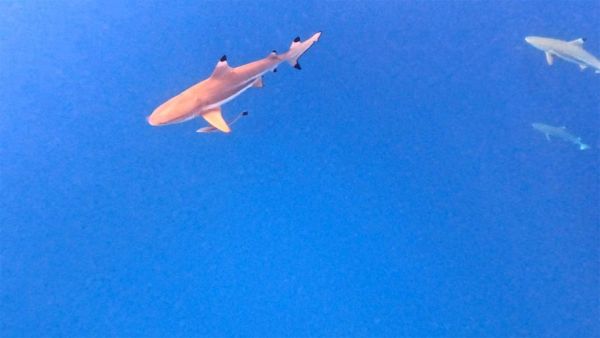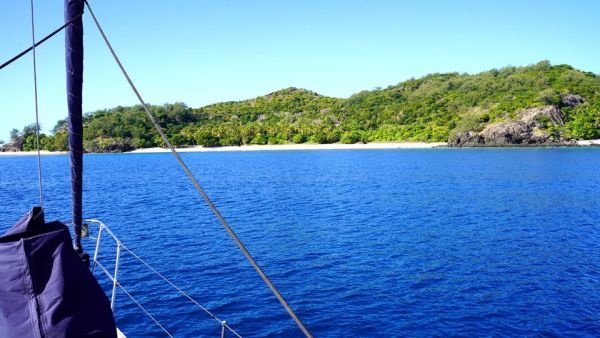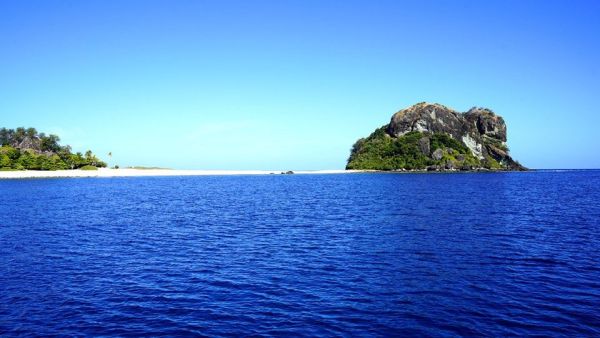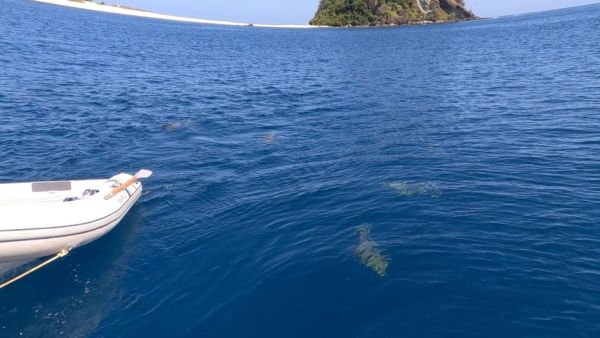Sailing to Navadra and Vanua Levu Islands, Fiji
August 1st, 2024
Navadra and Vanua Levu Islands are the northern most islands in the Mamanuca Island chain and lies approximately 9 nautical miles south from the Waya Island in the Yasawa Islands. This was our first stop after leaving Vuda Marina, which was a 25 nautical mile sail in 25 knots off the quarter. We hadn't done any research of this anchorage except that we knew they film here occasionally and that it was uninhabited. As we cleared the eastern side of Navadra Island to enter the anchorage, we were struck by the natural beauty of these islands. Lush green vegetation, white sandy beaches, and the most amazing rock formations and colours, our eyes were desperate to take it all in.

Black tip reef sharks circling Te Tāiko as we were laying our anchor
Ready to set our anchor, we suddenly noticed five black tip reef sharks circling Te Tāiko. The water in this anchorage is so clear that it wasn't hard to make out their shapes or see the remora fish that were attached to some of them. This was Vicki's first time seeing a black tip reef shark and in all the anchorages we had been in Fiji, this was the first time any sharks or fish had circled our boat. We did a bit of reading about them later and we figured that perhaps they were expecting some food from us...maybe fish? It seems to be a behaviour they do when a new boat enters the anchorage.

The crystal clear water gives us the opportunity to see the small fish seeking shade from Te Tāiko
There were a few boats inside the anchorage and at low tide the reefs surrounding us near the shore become more visible. There were some strong winds forecasted in the next couple of days so we decided we would stay here. The first night was fine but the second night we learned something new about this anchorage and perhaps the reason many of the other boats anchored here the previous night left. It is very rolly. Although the anchorage provides some protection from the east and south winds, it is exposed to the north which allows any ocean swell from the north to enter the anchorage. This alone makes the anchorage very rolly and uncomfortable at times. For us it seemed even worse at high tide. Te Tāiko was rolling around in the 0.5 m swell and we and everything else inside of her were rolling around like billiard balls! Some reading later, we soon learned that although there are times that this anchorage can be 'calm' (like our first night), it is well known for its rolly nature.

View of Vanua Levu Island from Te Tāiko
We decided to stay as planned and when the strong south east winds kicked in, we began to question our decision. Not because of the wind, we were sheltered enough from that, but more so from the wind chop that was now added to the 0.5 m swell. We felt like a bucking bronco as Te Tāiko rolled around. Dishes went flying. Anything left unsecured was soon thrown from its place. We would endure this for about 4 hours before the wind and wind chop would start to settle. The ocean swell didn't settle though and that continued to make it uncomfortable for the remainder of our time here.

View from Te Tāiko looking south past Vanua Levu Island where Tītī was heading after breaking loose
We felt like we were back at sea and needing to hold on and sleep in the saloon berths. We were the only boat in the anchorage for most of the day until a catamaran joined us. The anchorage became rough during the strong wind due to the swell and wind chop that we didn't notice that Tītī (our tender) had broken loose from the stern and was floating away. We had seen her just a few minutes before (while the catamaran was laying their anchor) but with a few minutes later the tender from the catamaran was launched, and they were speeding towards the beach. They had noticed that our tender was adrift...we had not! We were so grateful to them for saving our tender because had they not been there, we don't know what we would've done.
This anchorage is truly beautiful and we were very sad to leave but after two very rolly nights, it was time for us to move on! As we weighed anchor we were farewelled by six black tip reef sharks following us out of the anchorage.

Black tip reef sharks farewelling us as we motor out of the anchorage
If you enjoy our videos and posts, please consider subscribing to our YouTube channel here.
If you'd like to support the making of these videos and posts, hop over to Patreon and join the crew here.